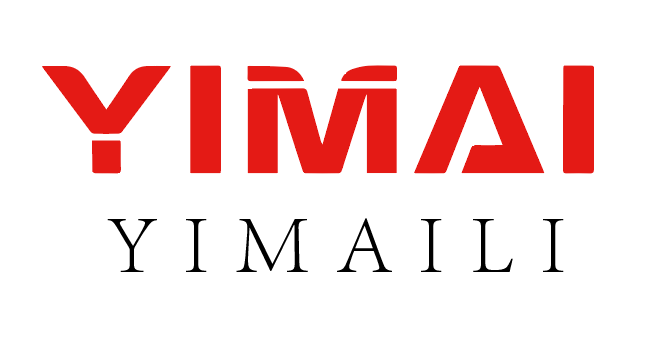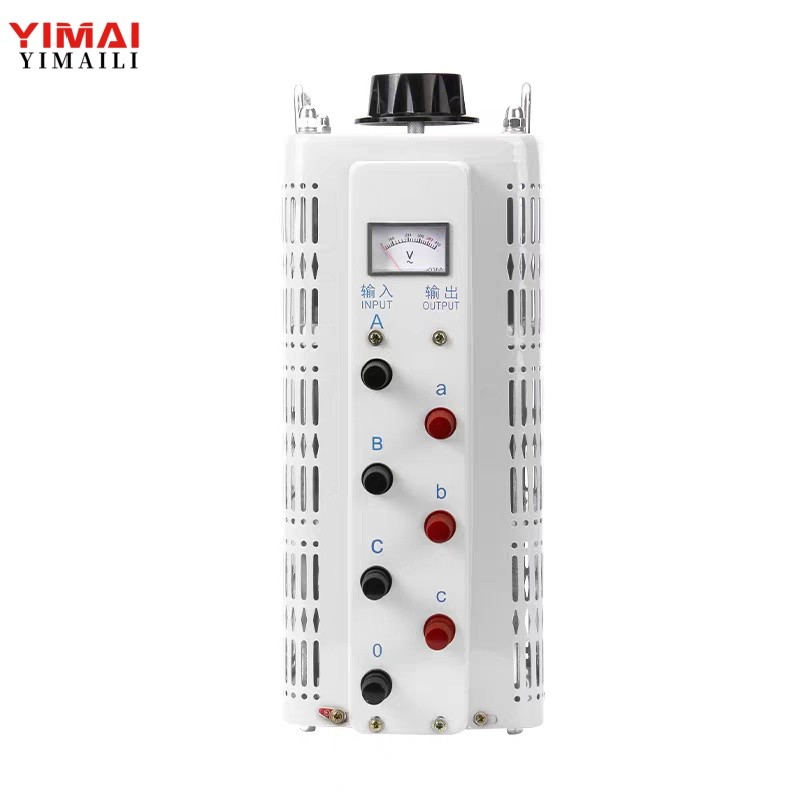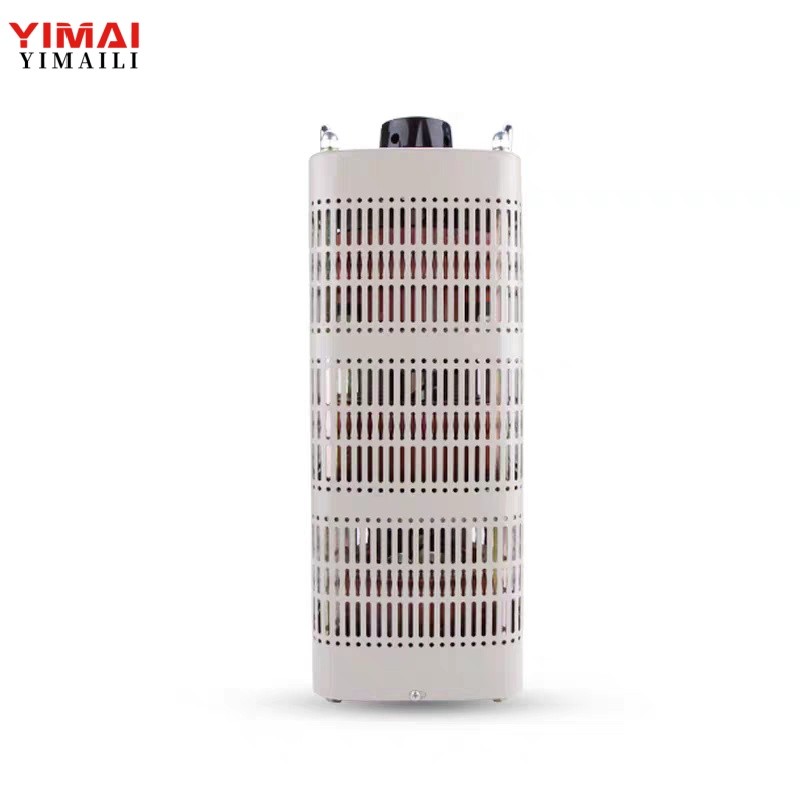
Three - phase contact autotransformer.
Core Function: It can continuously and smoothly adjust the three - phase AC output voltage by changing the turns ratio of the winding, and can provide an adjustable power supply with a voltage ranging from 0 to slightly higher than the input voltage (usually 380V input, and the output can reach about 430V) for the load.
- Information
1.Structure and Working Principle
Structural Composition: It mainly consists of three - phase windings, sliding brushes, a voltage regulating handle, a voltmeter (used to display the output voltage), input/output terminals (in the figure, "INPUT" corresponds to the three - phase input terminals A, B, and C, "OUTPUT" corresponds to the three - phase output terminals a, b, and c, and there is also a common terminal "0"), heat dissipation ventilation holes (to ensure heat dissipation of the equipment), and a shell, etc.
Working Principle: Based on the principle of autotransformer, the three - phase winding has taps and is in contact with the sliding brush. When the voltage regulating handle is rotated, the brush slides on the winding, changing the number of winding turns connected to the output circuit, thereby changing the output voltage. The sliding contact between the brush and the winding enables the output voltage to be continuously adjusted, achieving stepless voltage regulation.
2. Technical Parameters
|
Technical Parameters |
Description |
|
Number of Phases |
Three - phase |
|
Input Voltage |
Usually three - phase 380V (AC), suitable for industrial standard three - phase power supply |
|
Output Voltage |
0 - 430V (AC) continuously adjustable, allowing accurate voltage adjustment according to load requirements |
|
Rated Capacity |
There are various specifications, such as 3kVA, 5kVA, 10kVA, etc. Different capacities correspond to different load power adaptation capabilities, and selection should match the total load power |
|
Voltage Regulation Method |
Manual voltage regulation. The voltage is adjusted by rotating the black voltage regulating handle at the top to drive the brush to slide, with intuitive and simple operation |
|
Insulation Grade |
Generally grade B or F, ensuring stable insulation performance within a certain temperature range and avoiding safety issues such as electric leakage |
|
Cooling Method |
Natural air cooling, relying on convection heat dissipation between the equipment's own ventilation holes and the surrounding air, suitable for most conventional use scenarios |
3.Performance Characteristics
Smooth Voltage Regulation: The output voltage is continuously adjustable without voltage mutation, and can provide a stable voltage change process for the load, especially suitable for equipment sensitive to voltage fluctuations.
Small Waveform Distortion: Due to autotransformer voltage regulation and based on the principle of electromagnetic induction, the output voltage waveform is close to a sine wave, which has little impact on the normal operation and performance of loads (such as motors, precision instruments, etc.).
High Efficiency: The autotransformer structure reduces energy loss during energy conversion. Compared with some other voltage regulating equipment, it has better energy transmission efficiency and can effectively save electric energy.
Convenient Operation: The manual voltage regulating handle is designed simply, and the output voltage can be monitored in real time in combination with the voltmeter, which is convenient for users to quickly adjust to the required voltage value.
Overload Capacity: It has a certain short - term overload capacity, but long - term overload will affect the service life of the equipment. When in use, it is necessary to ensure that the load power does not exceed the rated capacity.
4.Applicable Scenarios
Industrial Production: In industries such as chemical engineering, metallurgy, and machinery manufacturing, it is used for soft starting of motors (reducing the impact on the power grid and motors through low - voltage starting), voltage regulation and temperature control of equipment (such as heating equipment controlling heating power and then controlling temperature through voltage regulation), and voltage regulation of power equipment on production lines.
Scientific Research Experiments: It provides an adjustable and stable power supply for three - phase electrical equipment in the laboratory (such as small three - phase motor test platforms, three - phase power electronic experimental devices, etc.) to meet the voltage requirements of different experiments.
Power Debugging and Maintenance: In the debugging and maintenance work of the power system, it is used to simulate different voltage working conditions and test the performance and stability of the equipment under different voltages.
Public Facilities: For three - phase electrical equipment in some public buildings (such as three - phase compressors of large central air conditioners, three - phase elevators, etc.), the voltage can be adjusted through a voltage regulator to ensure the stable operation of the equipment or adapt to the voltage fluctuation of the power grid.
5. Precautions for Use
Load Matching: Before use, the total load power shall be calculated accurately to ensure that it does not exceed the rated capacity of the voltage regulator, so as to avoid damage to the equipment due to overload.
Wiring Specifications: The input and output wiring shall be strictly connected in accordance with the terminal identification (A, B, and C for three - phase input, a, b, and c for three - phase output, and "0" for the common terminal), and the wiring shall be firm to prevent problems such as poor contact, heating, and even electric arc caused by loosening.
Heat Dissipation Environment: The voltage regulator will generate heat during operation and should be installed in a well - ventilated place to avoid debris around blocking the ventilation holes and affecting the heat dissipation effect.
Operation Safety: When adjusting the voltage, the handle shall be rotated slowly to avoid voltage mutation caused by too fast adjustment and impact on the load; When the equipment is in operation, do not touch live parts such as terminals unless necessary to ensure personal safety.
Regular Maintenance: Regularly check the wear of brushes, whether the winding surface is oxidized or...
1.Structure and Working Principle
Structural Composition: It mainly consists of three - phase windings, sliding brushes, a voltage regulating handle, a voltmeter (used to display the output voltage), input/output terminals (in the figure, "INPUT" corresponds to the three - phase input terminals A, B, and C, "OUTPUT" corresponds to the three - phase output terminals a, b, and c, and there is also a common terminal "0"), heat dissipation ventilation holes (to ensure heat dissipation of the equipment), and a shell, etc.
Working Principle: Based on the principle of autotransformer, the three - phase winding has taps and is in contact with the sliding brush. When the voltage regulating handle is rotated, the brush slides on the winding, changing the number of winding turns connected to the output circuit, thereby changing the output voltage. The sliding contact between the brush and the winding enables the output voltage to be continuously adjusted, achieving stepless voltage regulation.
2. Technical Parameters
|
Technical Parameters |
Description |
|
Number of Phases |
Three - phase |
|
Input Voltage |
Usually three - phase 380V (AC), suitable for industrial standard three - phase power supply |
|
Output Voltage |
0 - 430V (AC) continuously adjustable, allowing accurate voltage adjustment according to load requirements |
|
Rated Capacity |
There are various specifications, such as 3kVA, 5kVA, 10kVA, etc. Different capacities correspond to different load power adaptation capabilities, and selection should match the total load power |
|
Voltage Regulation Method |
Manual voltage regulation. The voltage is adjusted by rotating the black voltage regulating handle at the top to drive the brush to slide, with intuitive and simple operation |
|
Insulation Grade |
Generally grade B or F, ensuring stable insulation performance within a certain temperature range and avoiding safety issues such as electric leakage |
|
Cooling Method |
Natural air cooling, relying on convection heat dissipation between the equipment's own ventilation holes and the surrounding air, suitable for most conventional use scenarios |
3.Performance Characteristics
Smooth Voltage Regulation: The output voltage is continuously adjustable without voltage mutation, and can provide a stable voltage change process for the load, especially suitable for equipment sensitive to voltage fluctuations.
Small Waveform Distortion: Due to autotransformer voltage regulation and based on the principle of electromagnetic induction, the output voltage waveform is close to a sine wave, which has little impact on the normal operation and performance of loads (such as motors, precision instruments, etc.).
High Efficiency: The autotransformer structure reduces energy loss during energy conversion. Compared with some other voltage regulating equipment, it has better energy transmission efficiency and can effectively save electric energy.
Convenient Operation: The manual voltage regulating handle is designed simply, and the output voltage can be monitored in real time in combination with the voltmeter, which is convenient for users to quickly adjust to the required voltage value.
Overload Capacity: It has a certain short - term overload capacity, but long - term overload will affect the service life of the equipment. When in use, it is necessary to ensure that the load power does not exceed the rated capacity.
4.Applicable Scenarios
Industrial Production: In industries such as chemical engineering, metallurgy, and machinery manufacturing, it is used for soft starting of motors (reducing the impact on the power grid and motors through low - voltage starting), voltage regulation and temperature control of equipment (such as heating equipment controlling heating power and then controlling temperature through voltage regulation), and voltage regulation of power equipment on production lines.
Scientific Research Experiments: It provides an adjustable and stable power supply for three - phase electrical equipment in the laboratory (such as small three - phase motor test platforms, three - phase power electronic experimental devices, etc.) to meet the voltage requirements of different experiments.
Power Debugging and Maintenance: In the debugging and maintenance work of the power system, it is used to simulate different voltage working conditions and test the performance and stability of the equipment under different voltages.
Public Facilities: For three - phase electrical equipment in some public buildings (such as three - phase compressors of large central air conditioners, three - phase elevators, etc.), the voltage can be adjusted through a voltage regulator to ensure the stable operation of the equipment or adapt to the voltage fluctuation of the power grid.
5. Precautions for Use
Load Matching: Before use, the total load power shall be calculated accurately to ensure that it does not exceed the rated capacity of the voltage regulator, so as to avoid damage to the equipment due to overload.
Wiring Specifications: The input and output wiring shall be strictly connected in accordance with the terminal identification (A, B, and C for three - phase input, a, b, and c for three - phase output, and "0" for the common terminal), and the wiring shall be firm to prevent problems such as poor contact, heating, and even electric arc caused by loosening.
Heat Dissipation Environment: The voltage regulator will generate heat during operation and should be installed in a well - ventilated place to avoid debris around blocking the ventilation holes and affecting the heat dissipation effect.
Operation Safety: When adjusting the voltage, the handle shall be rotated slowly to avoid voltage mutation caused by too fast adjustment and impact on the load; When the equipment is in operation, do not touch live parts such as terminals unless necessary to ensure personal safety.
Regular Maintenance: Regularly check the wear of brushes, whether the winding surface is oxidized or...




